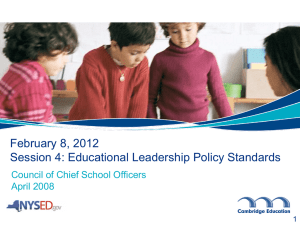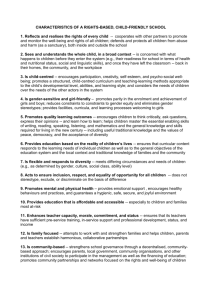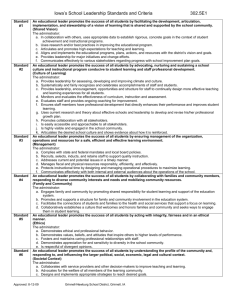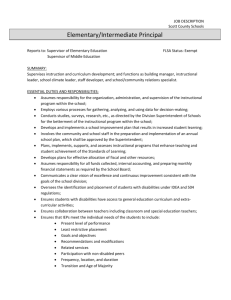draft - Working Together to Prepare Illinois School Leaders
advertisement
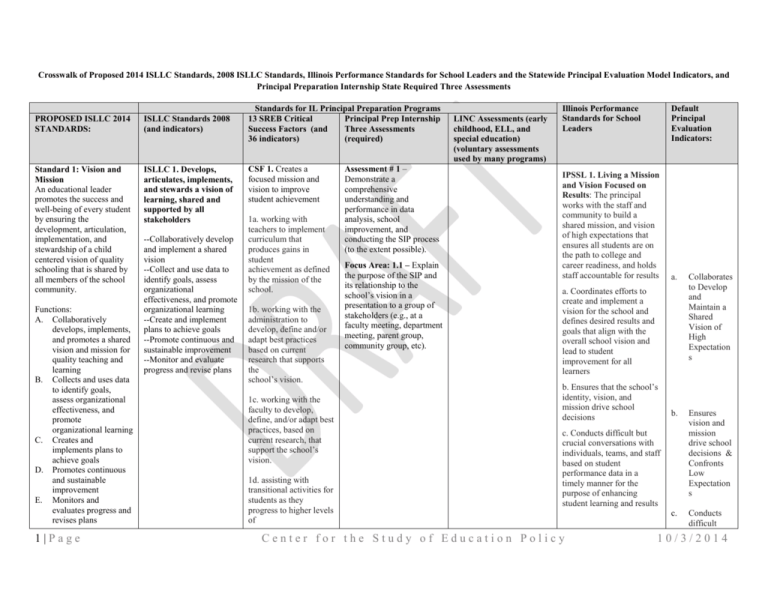
Crosswalk of Proposed 2014 ISLLC Standards, 2008 ISLLC Standards, Illinois Performance Standards for School Leaders and the Statewide Principal Evaluation Model Indicators, and Principal Preparation Internship State Required Three Assessments PROPOSED ISLLC 2014 STANDARDS: ISLLC Standards 2008 (and indicators) Standard 1: Vision and Mission An educational leader promotes the success and well-being of every student by ensuring the development, articulation, implementation, and stewardship of a child centered vision of quality schooling that is shared by all members of the school community. ISLLC 1. Develops, articulates, implements, and stewards a vision of learning, shared and supported by all stakeholders Functions: A. Collaboratively develops, implements, and promotes a shared vision and mission for quality teaching and learning B. Collects and uses data to identify goals, assess organizational effectiveness, and promote organizational learning C. Creates and implements plans to achieve goals D. Promotes continuous and sustainable improvement E. Monitors and evaluates progress and revises plans 1|Page --Collaboratively develop and implement a shared vision --Collect and use data to identify goals, assess organizational effectiveness, and promote organizational learning --Create and implement plans to achieve goals --Promote continuous and sustainable improvement --Monitor and evaluate progress and revise plans Standards for IL Principal Preparation Programs 13 SREB Critical Principal Prep Internship Success Factors (and Three Assessments 36 indicators) (required) CSF 1. Creates a focused mission and vision to improve student achievement 1a. working with teachers to implement curriculum that produces gains in student achievement as defined by the mission of the school. 1b. working with the administration to develop, define and/or adapt best practices based on current research that supports the school’s vision. 1c. working with the faculty to develop, define, and/or adapt best practices, based on current research, that support the school’s vision. 1d. assisting with transitional activities for students as they progress to higher levels of Assessment # 1 – Demonstrate a comprehensive understanding and performance in data analysis, school improvement, and conducting the SIP process (to the extent possible). Focus Area: 1.1 – Explain the purpose of the SIP and its relationship to the school’s vision in a presentation to a group of stakeholders (e.g., at a faculty meeting, department meeting, parent group, community group, etc). LINC Assessments (early childhood, ELL, and special education) (voluntary assessments used by many programs) Illinois Performance Standards for School Leaders Default Principal Evaluation Indicators: IPSSL 1. Living a Mission and Vision Focused on Results: The principal works with the staff and community to build a shared mission, and vision of high expectations that ensures all students are on the path to college and career readiness, and holds staff accountable for results a. Collaborates to Develop and Maintain a Shared Vision of High Expectation s b. Ensures vision and mission drive school decisions & Confronts Low Expectation s c. Conducts difficult a. Coordinates efforts to create and implement a vision for the school and defines desired results and goals that align with the overall school vision and lead to student improvement for all learners b. Ensures that the school’s identity, vision, and mission drive school decisions c. Conducts difficult but crucial conversations with individuals, teams, and staff based on student performance data in a timely manner for the purpose of enhancing student learning and results Center for the Study of Education Policy 10/3/2014 F. Acts in ways that consistently reflect the school's/district's vision, mission, and values placement (e.g., elementary to middle, middle to high school, high school to higher education). Conversatio ns to Improve Student Results CSF 8. Understands the change process and has the leadership and facilitation skills to manage change effectively 8a. working with faculty and staff in professional development activities. Standard 2: Instructional Capacity An educational leader promotes the success and well-being of every student by enhancing instructional capacity. Functions: A. Recruits and hires effective teachers and other professional staff B. Develops individual and collective capacity of staff C. Ensures on-going and differentiated professional learning D. Supports staff with human, financial, and technological resources E. Employs researchanchored and valid 2|Page ISLLC 2. Advocates, nurtures, and sustains a school culture and instructional program conducive to student learning and staff professional growth --Nurture and sustain a culture of collaboration, trust, learning, and high expectations --Create a comprehensive, rigorous and coherent curricular program --Create a personalized and motivating learning environment for students --Supervise instruction 8b. inducting and/or mentoring new teaching staff. 8c. building a “learning community” that includes all stakeholders. CSF 2.Sets high expectations for all students to learn higherlevel content 2a. developing/overseeing academic recognition programs that acknowledge and celebrate student’s success at all levels of ability. 2b. activities resulting in raising standards and academic achievement for all students and teachers. 2c. authentic assessments of student work through the use Assessment # 1 – Demonstrate a comprehensive understanding and performance in data analysis, school improvement, and conducting the SIP process (to the extent possible). Focus Area: 1.2 – Analyze and review data, including but not limited to, state test results, and work with a faculty group/team to identify areas for improvement and interventions, with particular attention given to NCLB subgroups and low performing students. Focus Area: 1.3 – Work with faculty or faculty a. Use student data to work collaboratively with teachers to modify curriculum and IPSSL 3 – Improving Teaching and Learning The principal works with the school staff and community to develop a research-based framework for effective teaching and learning that is refined continuously to improve instruction for all students. a. Works with and engages staff in the development and continuous refinement of a shared vision for effective teaching and learning by implementing a standards based curriculum, relevant to student needs and interests, researchbased effective practice, academic rigor, and high expectations for student Center for the Study of Education Policy a. Implements Curricular Scope and Sequence & Reviews Instructional Practices b. Implements Data Driven Decision Making 10/3/2014 F. G. systems of performance management Buffers learning and teaching from disruptive forces Provides emotional support to staff teachers and other professional staff Standard 3: Instruction An educational leader promotes the success and well-being of every student by promoting instruction that maximizes student learning. Functions: A. Maintains a culture of high expectations and challenge B. Ensures a focus on authenticity and relevance in instruction C. Ensures that instruction is anchored on best understandings of child development D. Ensures strengthsbased approaches to learning and teaching E. Ensures the use of effective pedagogy to close learning gaps F. Provides ongoing, salient, informative, and actionable feedback to teachers and other professional staff G. Ensures the use of pedagogy that treats students as individuals and promotes selfesteem 3|Page --Develop assessment and accountability systems to monitor student progress and/or evaluation of rubrics, end of course tests, projects. --Develop the instructional and leadership capacity of staff CSF. 3. Recognizes and encourages implementation of good instructional practices that motivate and increase student achievement --Maximize time spent on quality instruction --Promote the use of the most effective and appropriate technologies to support teaching and learning --Monitor and evaluate the impact of the instructional program. 3a. using a variety of strategies to analyze and evaluate the quality of instructional practices being implemented in a school. 3b. working with teachers to select and implement appropriate instructional strategies that address identified achievement gaps. 3c. working on a school team to prioritize standards and map curriculum in at least one content area across all grade levels of the school. 3d. working with a group of teachers to unwrap adopted standards and develop assignments and assessments aligned with the standards. 3e. working with a school team to monitor implementation of an adopted curriculum. teams to create, implement, and formatively evaluate a school improvement action plan. Focus Area: 1.4 –Work with faculty or faculty teams to gather and examine data to assess progress on the SIP and made recommendations for improvements or modifications to the SIP for the following year. Assessment #2 Demonstrate comprehensive understanding and performance in conducting teacher hiring, evaluation, and professional development Focus Area: 2.2 Conduct a full cycle of clinical supervision, including a pre-conference, conference, and post-conference. Write a summary utilizing actual notes, observations, discussion, forms, and student achievement data providing feedback to the teacher. Provide examples of interventions and support needed for the non-tenured or struggling teacher. Focus Area: 2.3 In conjunction with stakeholders lead in the development of a professional development plan for a school building that included: (1) data analysis (reviewed in Focus Area 1.2); (2) multiple instructional strategies to meet the needs of each student, including ELLs and students with disabilities, and to incorporate the data into the School Improvement Plan f. Analyze and use student information to design instruction that meets the diverse needs of students and leads to ongoing growth and development of all students. g. Recognize the individual needs of students and work with special education and bilingual education teachers to develop school support systems so that teachers can differentiate strategies, materials, pace, levels of complexity, and language to introduce concepts and principles so that they are meaningful to students at varying levels of development and to students with diverse learning needs. performance in every classroom. b. Creates a continuous improvement cycle that uses multiple forms of data and student work samples to support individual, team, and school-wide improvement goals, identify and address areas of improvement and celebrate successes c. Implements student interventions that differentiate instruction based on student needs d. Selects and retains teachers with the expertise to deliver instruction that maximizes student learning e. Evaluates the effectiveness of teaching and holds individual teachers accountable for meeting their goals by conducting frequent formal and informal observations in order to provide timely, written feedback on instruction, preparation and classroom environment as part of the district teacher appraisal system. f. Ensures the training, development, and support for high-performing instructional teacher teams to support adult learning and development to advance student learning and performance g. Supports the system for providing data-driven Center for the Study of Education Policy c. Uses Disaggregat ed Data d. Selects and Assigns Effective Teachers & Retains Effective Teachers e. Observes Staff and Gives Feedback; Evaluates Staff f. Develops an Instructional Team g. Implements Professional Learning h. Promotes Growth of Technology a. Links 10/3/2014 H. I. J. Ensures the presence of culturally congruent pedagogy and assessment Monitors instruction and instructional time Employs technology in the service of teaching and learning Standard 4: Curriculum and Assessment An educational leader promotes the success and well-being of every student by promoting robust and meaningful curricula and assessment programs. Functions: A. Ensures program rigor B. Ensures culturally relevant curricula and assessments C. Maximizes opportunity to learn D. Ensures authentic learning and assessment experiences E. Emphasizes assessment systems congruent with understandings of child development and standards of measurement F. Ensures the use of learning experiences that enhance the enjoyment of learning 3f. involvement in the work of literacy and numeracy task forces. 3g. working with curriculum that is interdisciplinary and provides opportunities for students to apply knowledge in various modalities across the curriculum. CSF 4. Creates a school where faculty and staff understand that every student counts— 4a. working with staff to identify needs of all students. 4b. collaborating with adults from within the school and community to provide mentors for all students. 4c. engaging in activities designed to increase parental involvement. 4d. engaging in parent/student/school collaborations that develop long-term educational plans for students. CSF 5. Uses data to initiate and continue improvement in school and classroom practices options for teacher development; and (3) a method for evaluating the plan leading to school improvement. Focus Area: 3.1 – Investigate, define, and delineate the systems and factors within the internship school for advocating, nurturing, and sustaining a culture of collaboration, trust, learning, and high expectations and a personalized and motivating learning environment for students. Focus Area: 3.3 – State the mission of the school. Determine and analyze the different systems that exist within the school to fulfill the school’s mission (i.e. instructional: curriculum, assessment, technology, class structure; and management: discipline plan; attendance; maintenance; transportation, etc.). Choose one instructional and one management system; create an assessment tool that was used to rate the two systems. Finally, develop recommendations for improvement of aspects of the two systems that need improvement and report the findings to the internship principal. professional development and sharing of effective practice by thoughtfully providing and protecting staff time intentionally allocated for this purpose h. Advances Instructional Technology within the learning environment IPSSL 6 CREATING AND SUSTAINING A CULTURE OF HIGH EXPECTATIONS— The principal works with staff and community to build a culture of high expectations and aspirations for every student by setting clear staff and student expectations for positive learning behaviors and by focusing on students’ social-emotional learning 5a. analyzing data (including standardized 4|Page Center for the Study of Education Policy a. Builds a culture of high aspirations and achievement for every student b. Requires staff and students to demonstrate consistent values and positive behaviors aligned to the school’s vision and mission c. Leads a school culture and environment that successfully develops the full range of students’ learning capacitiesacademic, creative, social-emotional, Aspirations to College and Career Opportuniti es & Develops a Student Goal Setting Process b. Translates the School Values into Specific Behaviors & Develops a Code of Conduct c. Creates a Culture That Supports Social Emotional Learning & Effective Effort 10/3/2014 test scores, teacher assessments, psychological data, etc.) to develop/refine instructional activities and set instructional goals. behavioral and physical. 5b. facilitating data disaggregation for use by faculty and other stakeholders. CSF 9. Understands concepts of adult learning and provide sustained professional development that benefits students 9a. study groups, problem-solving sessions and/or ongoing meetings to promote student achievement. 9b. scheduling, developing and/or presenting professional development activities to faculty that positively impact student achievement. CSF 13. Is a life-long learner continuously learning and seeking out colleagues to keep abreast of new research and proven practices 13a. working with faculty to implement research-based instructional practices. 5|Page Center for the Study of Education Policy 10/3/2014 13b. working with professional groups and organizations. Standard 5: Community of Care for Students An educational leader promotes the success and well-being of every student by promoting the development of an inclusive school climate characterized by supportive relationships and a personalized culture of care. Functions: A. Ensures the formation of a culture defined by trust B. Ensures that each student is known, valued, and respected C. Ensures that students are enmeshed in a safe, secure, emotionally protective, and healthy environment D. Ensures that each student has an abundance of academic and social support E. Ensures that each student is an active member of the school Standard 6: Professional Culture for Teachers and Staff An educational leader promotes the success and well-being of every student by promoting professionally normed communities for teachers 6|Page ISLLC 3. Manages the school, its operations and resources for a safe, efficient, and effective learning environment CSF 10. Uses and organizes time in innovative ways to meet the goals of school improvement --Monitor and evaluate the management and operational systems 10a. scheduling of classroom and/or professional development activities in a way that provides meaningful time for school improvement activities. --Obtain, allocate, align, and efficiently utilize human, fiscal, and technological resources --Promote and protect the welfare and safety of students and staff --Develop the capacity for distributed leadership --Ensure teacher and organizational time is focused to support quality instruction and student learning 10b. scheduling time to provide struggling students with the opportunity for extra support (e.g., individual tutoring, small-group instruction, extendedblock time) so that they may have the opportunity to learn to mastery. CSF 11 Acquires and use resources wisely 11a. writing grants or developing partnerships that provide needed resources for school improvement. 11b. developing schedules that maximize student learning in meaningful ways with measurable success. Assessment #2 Demonstrate comprehensive understanding and performance in conducting teacher hiring, evaluation, and professional development. IPSSL. 2. Leading and Managing Systems Change: The principal creates and implements systems to ensure a safe, orderly, and productive environment for student and adult learning toward the achievement of school and district improvement priorities Focus Area: 2.1 Participate in the hiring process including, at a minimum: creation of a job description; creation of interview questions and assessment rubric; participation in interviews for the position; recommendation of the candidate to hire with rationale and data to support the selection; and preparation of letters of rejection for candidates who were not selected. 2.2 Conduct a full cycle of clinical supervision, including a pre-conference, conference, and postconference. Write a summary utilizing actual notes, observations, discussion, forms, and student achievement data providing feedback to the teacher. Provide examples of interventions and support needed for the non-tenured or struggling teacher. a. a. Develops, implements, and monitors the outcomes of the school improvement plan and school wide student achievement data results to improve student achievement b. Creates a safe, clean and orderly learning environment b. c. Collaborates with staff to allocate personnel, time, material, and adult learning resources appropriately to achieve the school improvement plan targets e. Proactively serve all students and their families with equity and honor and advocate on their behalf, ensuring an opportunity to learn and the well-being of each child in the classroom. d. Employs current technologies c. Assesses the Current State of School Performanc e& Develops a School Improveme nt Plan & Maintains a Focus on Result Builds, evaluates and develops a team of educators and support staff to ensure the learning environment is safe, clean, and orderly Allocates Resources to Support Student Learning Focus Area: 3.2 – Review the school’s budget and Center for the Study of Education Policy 10/3/2014 and other professional staff. Functions: A. Develops productive relationships and trust B. Nurtures a commitment to shared goals C. Provides for collaborative work D. Facilitates shared ownership E. Develops collaborative leadership skills F. Promotes a climate of collective efficacy G. Fosters and supports the growth of trust H. Nurtures a culture of shared accountability other school resources with the internship principal. Detail how the resources are typically used; how the resources could be evaluated for adequacy; assessed for effectiveness and efficiency; and gave recommendations for improvement. Address specifically the impact of the budget on subgroups such as special education, ELL, and low socioeconomic students. Present recommendations for improvement to a faculty or faculty group for input in the budget development process. Standard 8: Operations and Management An educational leader promotes the success and well-being of every student by ensuring effective and efficient management of the school or district to promote student social and academic learning. Functions: A. Develops and demonstrates wellhoned interpersonal skills B. Manages student behavior with a focus on learning C. Ensures effective leadership throughout the school or district D. Crafts and connects management operations, policies, and resources to the vision and values of the school 7|Page Center for the Study of Education Policy 10/3/2014 E. Monitors and evaluates all aspects of school or district operations for effect and impact F. Ensures the implementation of data systems that provide actionable information G. Uses technology at the school or district to improve operations H. Manages organizational politics with an eye on school or district values and mission I. Enables others to understand and support relevant laws and policies J. Acts as a steward of public funds K. Develops and manages relationships with the district office or the school board Standard 7: Communities of Engagement for Families An educational leader promotes the success and well-being of every student by promoting communities of engagement for families and other stakeholders. Functions: A. Promotes understanding, appreciation, and use of the community's diverse cultural, social, and intellectual resources B. Nurtures a sense of approachability and sustains positive 8|Page ISLLC 4. Collaborates with faculty and community members, responds to diverse community interests and needs, and mobilizes community resources --Collect and analyze data and information pertinent to the educational environment --Promote understanding, appreciation, and use of the community’s diverse, cultural, social, and intellectual resources --Build and sustain CSF 6. Effectively communicates to keep everyone informed and focused on student achievement 6a. analyzing and communicating school progress and school achievement to teachers, parents and staff. 6b. gathering feedback regarding the effectiveness of personal communication skills. CSF 12. Obtains support from central Assessment # 3 – Demonstrate comprehensive understanding and performance in conducting school-wide management of personnel, resources, and systems for adequacy and equity. Focus Area: 3.1 – Investigate, define, and delineate the systems and factors within the internship school for advocating, nurturing, and sustaining a culture of collaboration, trust, learning, and high expectations and a personalized and motivating learning h. Evaluate a school to ensure the use of a wide range of printed, visual, or auditory materials and online resources appropriate to the content areas and the reading needs and levels of each student (including ELLs, students with IPSSL. 4. Building and Maintaining Collaborative Relationships: The principal creates a collaborative school community where the school staff, families, and community interact regularly and share ownership for the success of the school a. Creates, develops and sustains relationships that result in active student engagement in the learning process b. Utilizes meaningful feedback of students, Center for the Study of Education Policy a. Builds Ongoing Relationship s b. Includes Multiple Voices and Perspectives 10/3/2014 C. D. E. F. relationships with families and caregivers Builds and sustains productive relationships with community partners in the government, nonprofit, and private sectors Advocates for policies and resources for the community Understands and engages with community needs, priorities, and resources Communicates regularly and openly with families and stakeholders in the wider community positive relationships with families and caregivers --Build and sustain productive relationships with community partners office, community and parent leaders to champion the school improvement agenda environment for students. i. 12a. working with faculty to communicate with school board and community stakeholders in a way that supports school improvement. 12b. working with faculty, parents and community to build collaboration and support for the school’s agenda. CSF 7. Partners with parents to create a structure for parent and educator collaborations for increased student achievement 7a. working in meaningful relationships with faculty and parents to develop action plans for student achievement. Standard 9: Ethical Principles and Professional Norms An educational leader promotes the success and 9|Page disabilities, and struggling and advanced readers) ISLLC 5. Acts with integrity, fairness, and in an ethical manner --Ensure a system of j. Assessment # 1 – Demonstrate a comprehensive understanding and performance in data In conjunction with special education and bilingual education teachers identify and select assessment strategies and devices that are nondiscriminatory to be used by the school, and take into consideration the impact of disabilities, methods of communication, cultural, background, and primary language on measuring knowledge and performance of students leading to school improvement. staff, families, and community in the evaluation of instructional programs and policies c. Proactively engages families and communities in supporting their child’s learning and the school’s learning goals d. Demonstrates an understanding of the change process and uses leadership and facilitation skills to manage it effectively c. Engages Families d. Builds Capacity to Manage Change & Demonstrat es Personal Resolve and Response to Challenges Work with teachers to develop a plan that focuses on the needs of the school to support services required to meet individualized instruction for students with special needs (i.e., students with IEPs, IFSPs, or Section 504 plans, ELLs, and students identified as gifted) IPSSL. 5. Leading with Integrity and Professionalism: The principal works with the Center for the Study of Education Policy 10/3/2014 well-being of every student by adhering to ethical principles and professional norms. Functions: A. Nurtures the development of schools that place children at the heart of education B. Acts in an open and transparent manner C. Maintains a sense of self-awareness and attends to his or her own learning D. Works to create productive relationships with students, staff, parents, and members of the extended school community E. Maintains a sense of visibility and is approachable to all stakeholders F. Acts as a moral compass for the school or district G. Safeguards the values of democracy, equity, justice, community, and diversity accountability for every student’s academic and social success analysis, school improvement, and conducting the SIP process (to the extent possible). --Model principals of selfawareness, reflective practice, transparency, and ethical behavior Focus Area: 1.2 – Analyze and review data, including but not limited to, state test results, and work with a faculty group/team to identify areas for improvement and interventions, with particular attention given to NCLB subgroups and low performing students. Focus Area: 3.2 – Review the school’s budget and other school resources with the internship principal. Detail how the resources are typically used; how the resources could be evaluated for adequacy; assessed for effectiveness and efficiency; and gave recommendations for improvement. Address specifically the impact of the budget on subgroups such as special education, ELL, and low socioeconomic students. Present recommendations for improvement to a faculty or faculty group for input in the budget development process. Standard 10: Equity and Cultural Responsiveness An educational leader promotes the success and well-being of every student by ensuring the development of an equitable and culturally responsive school. ISLLC 6. Understands, responds to, and influences the larger political, social, economic, legal, and cultural context 10 | P a g e --Safeguard the values of democracy, equity, and diversity --Consider and evaluate the potential moral and legal consequences of decision-making --Promote social justice and ensure that individual student needs inform all aspects of schooling --Advocate for children, families and caregivers --Act to influence local, school staff and community to create a positive context for learning by ensuring equity, fulfilling professional responsibilities with honesty and integrity, and serving as a model for the professional behavior of others a. Treats all people fairly, equitably, and with dignity and respect b. Demonstrates personal and professional standards and conduct that enhance the image of the school and the educational profession. Protects the rights and confidentiality of students and staff c. Creates and supports a climate that values, accepts and understands diversity in culture and point of view a. Models equity and dignity b. Protects Rights and Confidential ity c. Recognizes the Strengths of a Diverse Population CSF 13. Is a life-long learner continuously learning and seeking out colleagues to keep abreast of new research and proven practices 13a. working with faculty to implement Center for the Study of Education Policy 10/3/2014 Functions: A. Ensures equity of access to social capital and institutional support B. Fosters schools as affirming and inclusive places C. Advocates for children, families, and caregivers D. Attacks issues of student marginalization; deficit-based schooling; and limiting assumptions about gender, race, class, and special status E. Promotes the ability of students to participate in multiple cultural environments F. Promotes understanding, appreciation, and use of diverse cultural, ecological, social, political, and intellectual resources district, state, and national decisions affecting student learning --Assess, analyze, and anticipate emerging trends and initiatives in order to adapt leadership strategies research-based instructional practices. 13b. working with professional groups and organizations. Standard 11: Continuous School Improvement An educational leader promotes the success and well-being of every student by ensuring the development of a culture of continuous school improvement. Functions: A. Assesses, analyzes, and anticipates emerging trends to shape school or district decision making B. Initiates and manages 11 | P a g e Center for the Study of Education Policy 10/3/2014 system-wide change Enables others to engage productively with change experiences D. Navigates change in the midst of ambiguity and competing demands and interests E. Promotes a culture of data-based inquiry and continuous learning F. Maintains a systems perspective and promotes coherence across all dimensions of the school or district G. Promotes a culture of collective direction, shared engagement, and mutual accountability C. 12 | P a g e Center for the Study of Education Policy 10/3/2014

